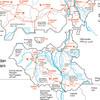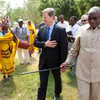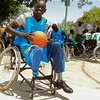Hunger prospects haunt south after mine awareness day
While ensuring food security is a top priority for the Government of Southern Sudan (GoSS), its efforts are also hampered by the presence of small arms ammunition, abandoned weapons caches, and portable air defence systems, local officials say.
One year ago Ochan Hanningtion demanded: "Release the landmine maps of Southern Sudan!"
For Madut Akol, a field coordinator at Sudan Integrated Mine Action Service (SIMAS), awareness of this "minescape" is only a part of the immense challenge facing the emerging nation when it comes to the future of agriculture.
Food security for Southern Sudan’s estimated 10 million inhabitants remains in doubt, he said, until landmines are completely cleared.
"Unless landmines are removed, I would say there is no shortcut to enabling local populations to produce enough food."
Stressing that the biggest numbers of returnees and IDPs (Internally Displaced Persons) have already arrived in the ten states of Southern Sudan, he added, "unless landmines are removed, I would say there is no shortcut to enabling local populations to produce enough food".
According to Akol, SIMAS has already completed a mine clearance operation in the region’s worst affected areas, including Liria town, about 40 km southeast of Juba. The organisation has also embarked on de-mining the highly contaminated areas of Loggo east, where some anti-tank landmines have reportedly been detected and destroyed.
 Lafon, Eastern Equatoria - UN Photo / Tim McKulka
Lafon, Eastern Equatoria - UN Photo / Tim McKulka
SIMAS has collaborated with key partners such as UNICEF, the United Nations Development Programme (UNDP), Mine Action Group (MAG) and the UN Mine Action Office (UNMAO) to provide education and guidance on mine risk to various communities.
According to UNICEF, more than 80,000 people received information on protection from mines and the promotion of safe behaviour last year alone, while an additional 157,000 had access to mine risk education through public media.
Akol further cited financial constraints and inadequate technical support as major challenges to the organisation’s normal operations, adding that the process of clearing landmines requires the collective involvement of all stakeholders, government and partners.
Funding by the South Sudan De-Mining Authority is crucial to success of the endeavour, he said.
The UN estimates that at least over 18,000 km of road have been surveyed and cleared of mines that have been found.
Listen to Marvis Birungi's reportage "New landmines planted in Southern Sudan"
"What remains is a great deal of work to clear unexploded ordnance," said David Gressly, Coordinator for the UN Mission in Sudan (UNMIS). According to UNMAO’s database, about half of the locations involved are yet to be cleared.



